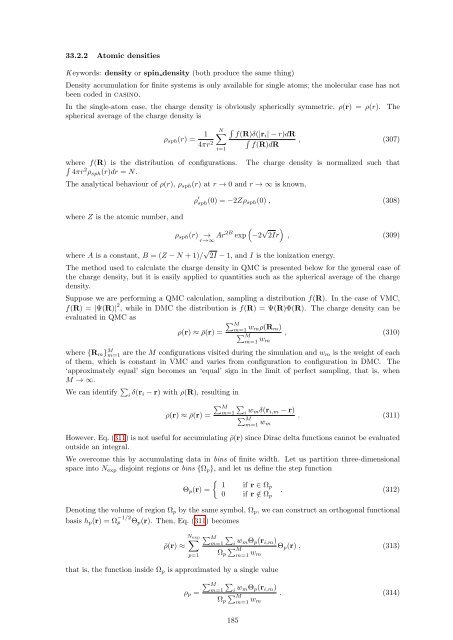CASINO manual - Theory of Condensed Matter
CASINO manual - Theory of Condensed Matter
CASINO manual - Theory of Condensed Matter
Create successful ePaper yourself
Turn your PDF publications into a flip-book with our unique Google optimized e-Paper software.
33.2.2 Atomic densities<br />
K eywords: density or spin density (both produce the same thing)<br />
Density accumulation for finite systems is only available for single atoms; the molecular case has not<br />
been coded in casino.<br />
In the single-atom case, the charge density is obviously spherically symmetric, ρ(r) = ρ(r).<br />
spherical average <strong>of</strong> the charge density is<br />
ρ sph (r) = 1<br />
4πr 2<br />
N ∑<br />
i=1<br />
The<br />
∫<br />
f(R)δ(|ri | − r)dR<br />
∫<br />
f(R)dR<br />
, (307)<br />
where ∫ f(R) is the distribution <strong>of</strong> configurations.<br />
4πr 2 ρ sph (r)dr = N.<br />
The charge density is normalized such that<br />
The analytical behaviour <strong>of</strong> ρ(r), ρ sph (r) at r → 0 and r → ∞ is known,<br />
ρ ′ sph(0) = −2Zρ sph (0) , (308)<br />
where Z is the atomic number, and<br />
(<br />
ρ sph (r) → Ar 2B exp −2 √ )<br />
2Ir , (309)<br />
r→∞<br />
where A is a constant, B = (Z − N + 1)/ √ 2I − 1, and I is the ionization energy.<br />
The method used to calculate the charge density in QMC is presented below for the general case <strong>of</strong><br />
the charge density, but it is easily applied to quantities such as the spherical average <strong>of</strong> the charge<br />
density.<br />
Suppose we are performing a QMC calculation, sampling a distribution f(R). In the case <strong>of</strong> VMC,<br />
f(R) = |Ψ(R)| 2 , while in DMC the distribution is f(R) = Ψ(R)Φ(R). The charge density can be<br />
evaluated in QMC as<br />
∑ M<br />
m=1<br />
ρ(r) ≈ ¯ρ(r) =<br />
w mρ(R m )<br />
∑ M<br />
m=1 w , (310)<br />
m<br />
where {R m } M m=1 are the M configurations visited during the simulation and w m is the weight <strong>of</strong> each<br />
<strong>of</strong> them, which is constant in VMC and varies from configuration to configuration in DMC. The<br />
‘approximately equal’ sign becomes an ‘equal’ sign in the limit <strong>of</strong> perfect sampling, that is, when<br />
M → ∞.<br />
We can identify ∑ i δ(r i − r) with ρ(R), resulting in<br />
∑ M ∑<br />
m=1 i<br />
ρ(r) ≈ ¯ρ(r) = w mδ(r i,m − r)<br />
∑ M<br />
m=1 w . (311)<br />
m<br />
However, Eq. (311) is not useful for accumulating ¯ρ(r) since Dirac delta functions cannot be evaluated<br />
outside an integral.<br />
We overcome this by accumulating data in bins <strong>of</strong> finite width. Let us partition three-dimensional<br />
space into N exp disjoint regions or bins {Ω p }, and let us define the step function<br />
{ 1 if r ∈ Ωp<br />
Θ p (r) =<br />
. (312)<br />
0 if r /∈ Ω p<br />
Denoting the volume <strong>of</strong> region Ω p by the same symbol, Ω p , we can construct an orthogonal functional<br />
basis h p (r) = Ω −1/2<br />
p Θ p (r). Then, Eq. (311) becomes<br />
¯ρ(r) ≈<br />
N exp<br />
∑<br />
p=1<br />
that is, the function inside Ω p is approximated by a single value<br />
∑ M ∑<br />
m=1 i w mΘ p (r i,m )<br />
∑ M<br />
Ω p m=1 w Θ p (r) , (313)<br />
m<br />
∑ M ∑<br />
m=1 i<br />
ρ p = w mΘ p (r i,m )<br />
∑ M<br />
Ω p m=1 w . (314)<br />
m<br />
185

















